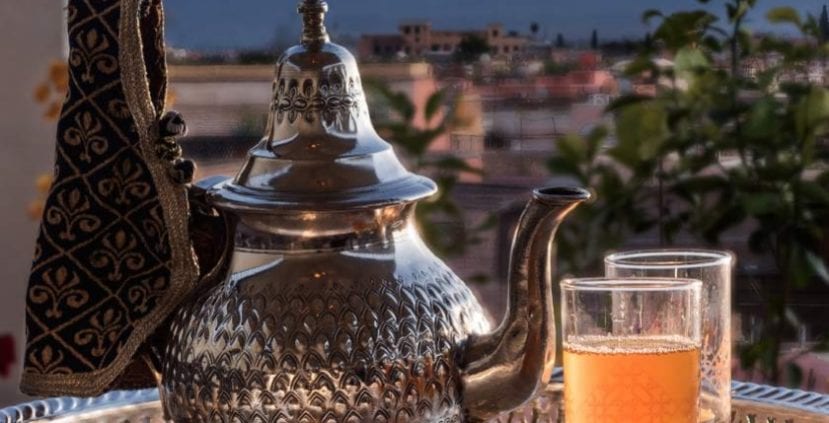
Brilliant sunlight floods the teaching kitchen at Riad Star. Though with its intricate chiselled stonework above, the symmetrical flowers and circles give a Mosque-like feel of adoration to this kitchen. It’s a little like cooking lunch in the Sistine Chapel. Though it’s not yet time to slave over a hot stove …
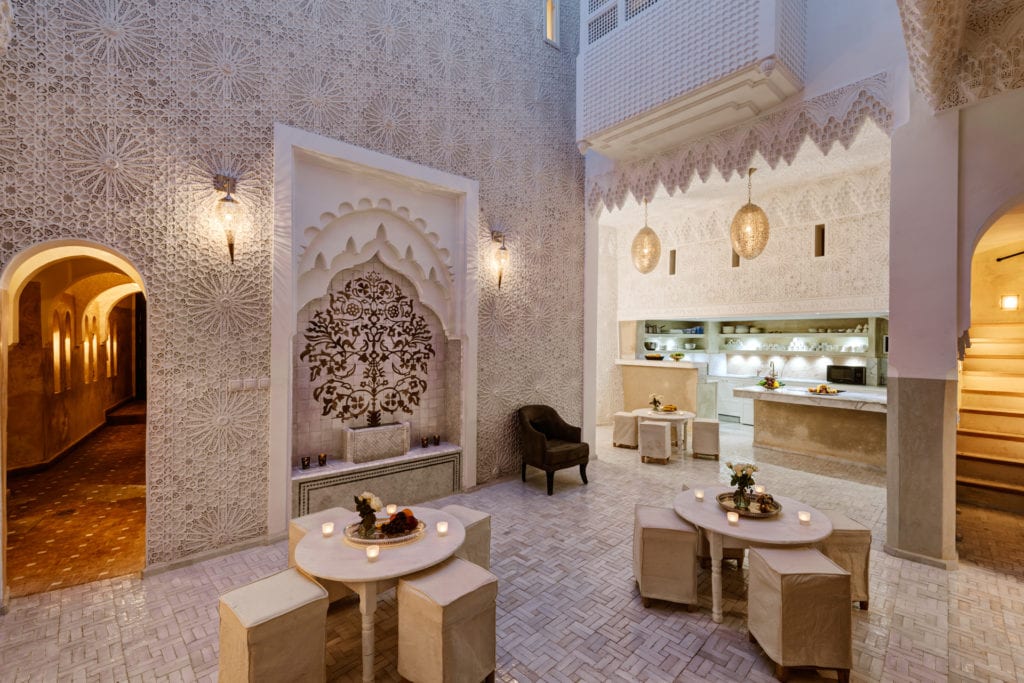
Khalifa, the Riad Star Cookery Course’s chef, grabs a wicker shopping basket. We leave Riad Star to weave through bicycles, donkey-drawn carts, hand carts, bicycles, men in age-old earth coloured djebellas, women in striking blue voluminous burkas. Navigating medieval ochre passages towards the souks. I can’t help but wonder if sidestepping raucous mopeds was on the curriculum of Khalifa’s two-year course at Marrakech’s Culinary Academy.
This is how the Moroccan people have shopped, lived and ate for a millennium – leaving aside whining mopeds. Every day they count up their Dirham, head for the souks and see what looks fresh. Only then do they decide upon the recipe for the day.
Back in the Riad Star Cookery Course kitchen are the core spices: black pepper, cumin, dried ginger, sweet red pepper and turmeric. Note no chilli. We are shopping for fresh ingredients. Moroccan cuisine is a gentle blend of flavours. Pricey saffron is bought fresh too. That may be for cash-flow reasons as much as fresh taste.
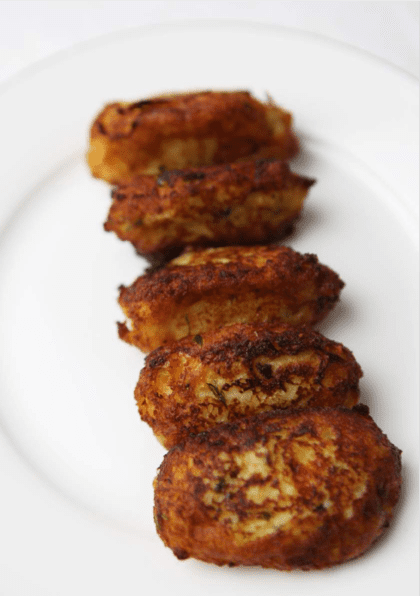
Khalifa thoughtfully, but quickly, selects carrots, courgettes, garlic, a glossy red onion, green peppers and outsize tomatoes. Almost without asking, the seller places a vigorous bunch of Morocco’s “sister herbs” – coriander and flat-leaf parsley – on top of the basket. They are almost a given in Moroccan cuisine, topping a basket of vegetables that have largely travelled less than 20 miles. In total, they cost around 14 Dirham, less than $2 but more than a £ or €. To put things in perspective the half gram of saffron, the merest minimalist pinch of chroci stamens, costs 10 Dirham.
“Like gold,” says Khalifa, shaking his head ruefully.
We walk on, over uneven cobbles and under a searing sun, until we stop at a dark hole in the compressed earth persimmon walls. This is the fishmonger.
Not only is today Friday, a holy day of prayer, it is the very heart of Ramadan. The fisherman of Essouria and Tangiers, on the Moroccan coast, have not been to sea.
“In Marrakech when times are hard we make a sardine sandwich for the fish tagine,” encourages Khalifa, miming how within twenty minutes he will be dipping the fillets of fish in a marinade of extra virgin olive oil and another coating of those core herbs.

Back in the kitchen, and we are working mise-en-place, creating a fish tagine at just the one large island.
Suddenly, as we chop vegetables and niftily skin bulbs of garlic, I get an image of Moroccan Mastermind and an Arabic judge shouting dramatically, “Sardines for a tagine? It’s a brave choice.”
Khalifa, who prefers movies to Moroccan Masterchef, supervises as I layer the tagine: bouquets of herbs, vegetables and those herby sardine sandwiches. Then tomatoes, peppers, olives and the key to success: plenty of saffron-infused warm water. Earthenware tagines soak up the water, so I keep adding it.
Moroccan chefs have to multi-task so meanwhile I have chopped up some courgettes and carrots: added spice and an egg. Then there’s a test of dexterity as I clumsily fold triangular samosa-like-parcels, briouats, around the mixture.
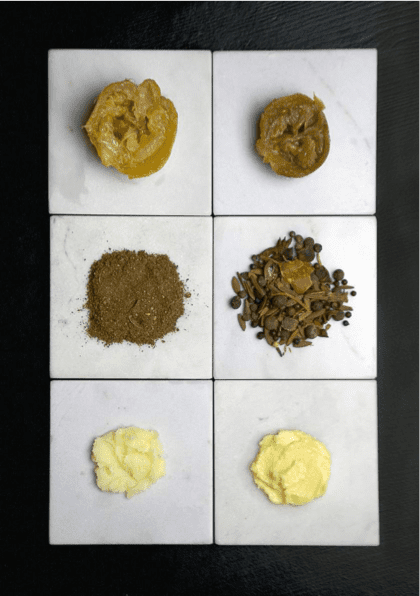
Whilst the tagine cooks I remember my first Moroccan tagine three decades previously in a remote High Atlas village as I prepared to scale Mount Toubkal. Although we were the first outsiders to visit for decades the villagers had a smattering of French. Whilst a huge tagine cooked in a large wall oven, one old lady told us that, “the Devil had been beating in her head for 20 years.” I gave her two paracetamol and the Devil was gone.
We sat cross-legged on the floor and our guide instructed us in tagine etiquette. Rolling the flat-bread into balls we were to use it to scoop up a helping of the couscous. Reaching across a neighbour to scoop up a choice piece of mutton was strictly forbidden.
This was a poor village and I only found just one morsel of lamb and two slithers of carrot when I made the mistake of putting my bread on the floor. A chicken snatched it, ran away and my meal was over. There was no more bread.
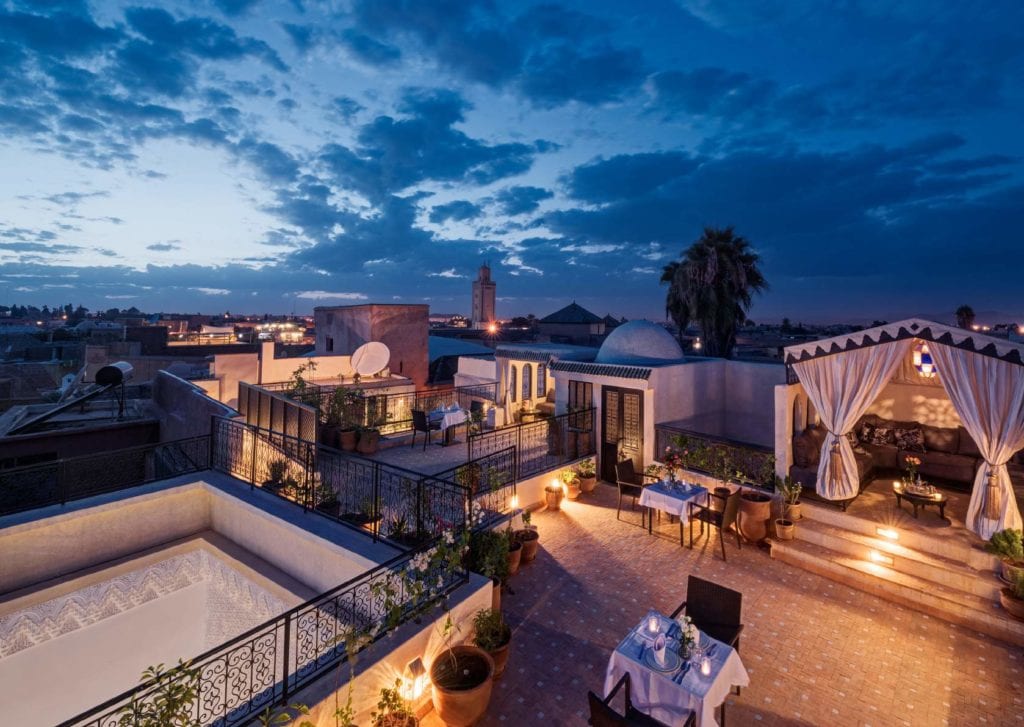
Thirty years on, my tagine, powered by rich pickings from the vegetable Souk and cooked in a contemporary kitchen is a far tastier experience. There are times when a dish can tell the developing story of a nation.

